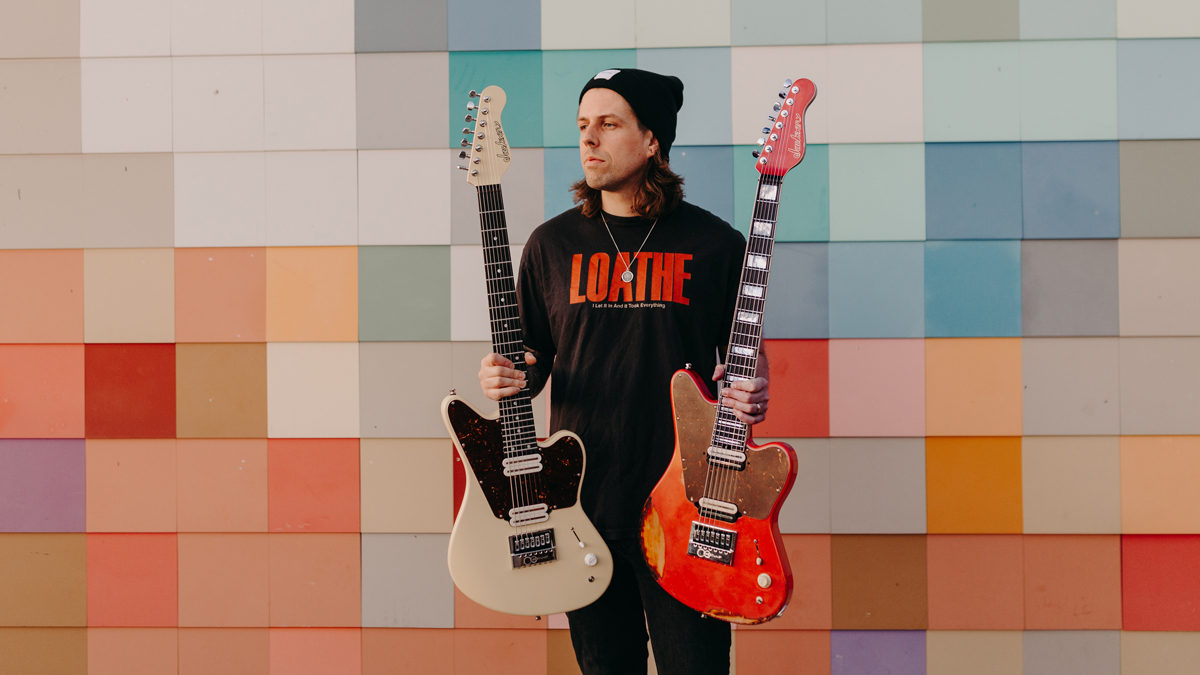
Something in the guitar world is stirring. Perhaps it’s the inevitable result of the great post-streaming genre-blur, or someone left a portal to the Upside Down open – but metal guitars have been creeping into the mainstream.
As such, we’re now in an age where pop stars are making B.C. Rich Warlock’s shimmer like semi-hollow Gretsches and bebop guitarists are ripping Wes Montgomery on Jacksons. Meanwhile, metal’s leading stars are swapping angular war machines for vintage-styled gear.
So, what’s flipping the guitar world upside down, and what does this mean for the industry? Are metal guitars going mainstream while becoming an endangered species in the genre they were built for?
A comfortable shock
From Phoebe Bridgers donning a B.C. Rich Warbeast on SNL to Willow riffing Deftones on a Jackson King V, Ladyhawke’s Jackson affinity, and Jacob Collier’s surprise signature Strandberg, metal guitars are an increasingly common sight in pop. But why?
For Helen Phillips, Director of Sales & Marketing for Jackson, EVH, Charvel, and Gretsch, there are two important factors to consider: Aesthetics and comfort.
“We see a lot of people using metal guitars for fashion and shock factor,” she says. “You want to be different and a guitar onstage is a tool for that. Your guitar is your workhorse, but on stage, it’s also your prop.”
Phillips also acknowledges that the slender genetics of metal guitars are well-suited to the biology of the female player.
“They can feel more comfortable for ladies,” she believes. “We don't want to be carrying around a really heavy Les Paul all gig – we’re just not built that way.
“It also shows the versatility of the guitars we build; Jackson and Charvel guitars are about the speed of playing and the comfortable neck – rolled edges, lightweight bodies – so it’s great to see these guitars break out of their stereotype.”
Metal at heart
It’s worth noting, though, that these ‘pop goes metal’ examples all come from authentic places: it’s not just about standing out from the crowd.
As a solo artist and with Boygenius, Phoebe Bridgers is often seen with a Floyd Rose and Fishman Fluence pickups equipped B.C. Rich Warbeast, or Bronze Series Warlock draped over her shoulder as she makes no effort to hide her love of metal.
Willow’s mother, Wicked Wisdom vocalist Jada Pinkett Smith, introduced her to heavy music. Now she hopes to widen its cultural appeal.
“I want women and girls of color to feel accepted and know that rock is for them,” she told Guitar World. “They can pick up the guitar, bass, drum sticks or microphone. I want to hear them scream and sing, putting all of their energy into this beautiful genre and change the world.”
Need for speed
Jackson guitars in particular are seeing a lot of extra-curricular love, with rock, pop, and jazz artists enjoying the metal axes' wafer-thin speed necks.
The Who's enigmatic Pete Townshend might own "literally hundreds of guitars” but his recent Jackson purchase is his first foray into heavy metal guitars. As Townshend told Guitarist, the instrument unlocked a warp-speed version of himself.
It just felt different. You put it in your hands and your brain changes
Lee Kiernan, IDLES
“I got it out of the box and it’s got very light strings. I was playing faster. No question. I was playing at three times the speed that I normally play at. And when I did fingering, drumming, it didn’t stop. It didn’t go thunk; it went ding because these guitars are built for a particular thing. I’m still learning and having fun with guitars.”
For IDLES’ Lee Kiernan, their latest album, TANGK, was driven by a desire to “break outside of the cycle.” His Jackson SL3 American Series Soloist has provided a game-changing shake-up.
“I bought it for new ways of writing,” he told Guitarist, “because I've played Fender forever. It just felt different. You put it in your hands and your brain changes. Otherwise you go to the same place.
“Repetition of practice is one of my biggest flaws as a guitarist. When I pick up my Fender Mustang, I go straight into barre chords without even thinking about it. This guitar made me think differently. It's the easiest guitar to play. You can tap for days, the fretboard is so flat.”
Defying expectation
Bebop guitarist Cecil Alexander sees his Jackson Dinky as an “anti-establishment” statement, even if it draws judgemental looks from his peers.
“A lot of jazz guitarists would shudder at the thought of playing a Jackson, but you should play what feels comfortable and allows you to express yourself,” he believes. I’m trying to make it okay for jazz guitarists to go out with their metal guitars.
A lot of jazz guitarists would shudder at the thought of playing a Jackson, but you should play what feels comfortable and allows you to express yourself
Cecil Alexander
“I’ve played 24-fret guitars in a jazz setting before. I used a PRS Santana at Berklee but with the neck pickup being offset, it made the tone too thin – the Jackson has the perfect brightness.”
Performing with it at a Wes Montgomery tribute show in San Diego recently, he said “It took less tweaking to get the tone than I initially thought it would,” proving that there are sonic benefits of metal guitars in non-metal settings.
“I was playing through a Fender Twin; I put the treble pretty high and used the tone knob to take a little bit of the unwanted like high-end out, but keeping the clarity from the high end of the amp. I tend to pick pretty close to the neck, and that warms things up quite a bit.”
In contrast, metal and heavy rock guitarists are moving in the opposite direction – albeit for the same reasons – and there’s a notable trend in players moving away from the pointy designs to more classic shapes.
Loathe guitarist Erik Bickerstaffe also wants to defy expectation and avoid stereotypes, hence why he’s swapped his ESP LTD SCT-607B for Squier and Gretsch baritones.
“With the image of the band, a B.C. Rich Warlock or a pointy seven-string Jackson wouldn’t make sense for what we are trying to put across. Baritones look like guitars, rather than metal guitars,” he says – even if there is some irony in his making a guitar he first discovered through The Beatles sound like a demon with road rage.
Oh, cliché
Just as these artists are embracing the wildcard aesthetic of metal guitars – see Ladyhawke’s luminous yellow Jackson X Series Kelly – metal guitarists are consciously avoiding clichés with their choices.
One very interesting thing that we have seen is the rise of the offset in metal... The Surfcaster has the neck and the feel of the Jackson, but to the eye, it doesn't look pointy or metal
Helen Phillips, Director of Sales & Marketing for Jackson
“One very interesting thing that we have seen is the rise of the offset in metal,” says Phillips.
“Bring Me The Horizon’s Lee Malia is playing Strats, Teles and a Surfcaster that's got the neck and the feel of the Jackson, but to the eye, it doesn't look pointy or metal. I think every guitarist wants a classic axe in their arsenal.”
Bridgers might be able to make her Warlock deploy shimmery cleans on Kyoto, but Phillips believes that “you can’t play proper nasty metal on a Fender Strat without fiddling with the guitar,” which is why Mike Stringer’s custom Jackson melds the best of both worlds together.
Borrowing the Charvel Surfcaster body and Fender headstock shapes for his Custom Shop build – a benefit of all three firms being part of the same family – it has all the hallmarks of a vintage guitar while being primed with an Evertune bridge, and Fishman Fluence humbuckers.

Like Misha Mansoor’s “Strat for progressive players,” and Adam Blackstone’s decidedly non-metal signature bass, the Jackson is far cry from the luthier's visual heritage. But it does nail the brief in looking like a ‘70s relic while sounding like a definitively modern instrument. So did building Stringer’s leftfield beauty feel like a risk? Phillips doesn’t think so.
“We're lucky because when we're developing guitars, we are developing alongside our artists; we see trends before they happen,” she explains. “We’re just accommodating; if someone who plays lots of festivals says a guitar with a certain look or style is what they want, they're not going to be alone in that.”
While Stringer’s vintage-modern builds are one-offs, there have been conscious moves from Jackson to appeal to players who want to blur the lines of genre via its American Virtuoso Series. It even offered up a hot pink colorway, perhaps as a nod to John Mayer previously adorning a hot pink Soloist, which Phillips observes “was all over the TV”.
Stringer’s guitars boast a silhouette similar to that of Volbeat guitarist Rob Caggiano’s signature Shadowcaster too, proving that the build isn’t uncharted territory for the luthier, just a continuation of a trend now hitting overdrive. A production run would likely be a shrewd move.
The road ahead
So, if manufacturers have their fingers firmly on the pulse of guitar trends, can we expect a wider cast of signature artists in the future?
“Building a guitar from start to finish takes a long time,” Phillips underlines. “We need to be sure that what we're seeing isn’t in one minute and out the next fashion-wise. We want to develop with our artists and learn from them. [But] we are open to everything.”
In the meantime, it’s a joy to see stereotypes so savagely skewered. What’s next? Well, who’s to say, but we’d pay good money to see Taylor Swift conclude her Eras tour with an Ibanez Stoneman...







